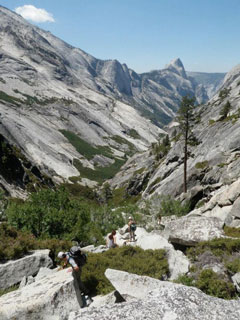On Tuesday, July 31, a father and his (adult) daughter arrived at Olmsted Point (on the Tioga Road, west of Tuolumne Meadows), intending to hike down to Yosemite Valley via the Snow Creek Trail. Neither hiker had been on this trail before, but according to their topographic map, it appeared to start near Olmsted Point. The Olmsted Point area features a network of confusing, braided, unofficial trails, created by hikers seeking a variety of scenic views. The pair set off from Olmsted Point, unwittingly following an unofficial trail, and soon noticed a sign that read, "To Yosemite Valley," with an arrow indicating a direction of travel that seemed correct for where they expected the Snow Creek Trail to be. Before long, however, the duo were bushwhacking downhill through thick brush, eventually arriving at the top of a drainage, east of Yasoo Dome, where they discovered a fixed rope tied to a tree, along with a climbing helmet.
When asked if seeing the fixed rope in the tree made him reconsider whether they were, in fact, on the Snow Creek Trail, the father explained the thoughts running through his mind at the time:
We need to keep going down to find the trail, because I can't find it up here [at the top of the drainage]. If we can get down to the bottom, to the waterway, that will lead us to the canyon, which will spit us out in the Valley. I'm not going to make my daughter go back uphill through that brush.
The pair used the rope to descend into the drainage. The father, recounting their journey later, said, "Neither of us has any rope experience at all. We used t-shirts to protect our hands and arms." Scrambling for hours down a steep slope covered with more dense patches of manzanita, the hikers followed the drainage to Tenaya Canyon. The terrain flattened out when the pair reached the floor of the canyon, making for much easier travelling. They hiked downhill, following Tenaya Creek, until the creek dropped over a waterfall with steep cliffs on either side, leaving them no means to descend farther. From this point in Tenaya Canyon, ropes and rappelling skills are essential for safe travel.
 |
|
Photo of Tenaya Canyon taken later this summer. (Photo by Greg Nespor.) |
Exhausted and running low on water, the two hikers could not fathom retracing their route back uphill through the unforgiving brush. The daughter discovered that, fortunately (and remarkably), her cell phone had service, so they called 911. The father was put in direct contact with park rangers, who concluded that the pair had descended the gully east of Yasoo Dome. Two Yosemite search and rescue (YOSAR) teams were sent out that evening, one on the path that the pair had followed and the other down the standard Tenaya Canyon descent. Meanwhile, knowing that teams would come looking for them, the hikers built a fire and hunkered down for the night.
The next morning, one of the search teams found the two hikers. They still had plenty of food and were relatively warm, thanks to the fire, but were moderately dehydrated. The pair was guided back to Olmsted Point by a more common route that included third-class scrambling.
The most important lessons from this incident are these:
- As soon as you realize you are no longer hiking on an established trail, and instead find yourself bushwhacking or scrambling on rugged terrain, stop. Do not keep going, thinking you're going to find the trail. Immediately backtrack until you find the correct route, even if that means hiking back uphill. The sooner you recognize your situation, the easier it will be to correct it.
- If you're hiking off trail and you cannot see every step of the way to your goal, you cannot evaluate the terrain. In the case at hand, a single 100-foot waterfall blocked their way to the Valley.
- Most wilderness areas in the park lack cell phone service. The father-daughter team was extremely fortunate to have service at the bottom of a canyon where both sides rise thousands of feet. The Yosemite Emergency Communications Center (ECC) was able to triangulate the 911 call, but only to within a three-mile radius with 90% accuracy. The coordinates put the pair on the near-vertical east slope of Yasoo Dome, nearly 2,000 feet above their actual location.
- The two hikers were using a topographic map, but it did not have the necessary close-up view. Bringing and knowing how to read a 7.5-minute topographic quadrangle map, which is more detailed, could have prevented the confusion at Olmsted Point and warned them of the hazardous terrain ahead of them.
The father-daughter pair made at least three smart decisions:
- The first was to stop when they did; through the years, hikers who were unprepared for vertical terrain yet continued descending farther into the canyon have been stranded and even killed.
- The father-daughter team brought a lighter, which allowed them to build a fire so they could stay warm through the night.
- Also important was the father's decision to give two different parties in the Tuolumne Meadows Campground their hiking itinerary; he explained where they were starting, where they were ending, and what trail they planned to take. He told his fellow campers that he and his daughter should return by Wednesday night, and instructed the campers to notify someone if their truck wasn't back in the campground by Thursday morning at the latest. Had the daughter's cell phone not had service, the itinerary given to their fellow campers would have proven crucial for their rescue.
A few days after the rescue, the father was asked what he would have done if rescuers hadn't been there, and the father answered, "I don't know. That question keeps running through my brain. I've already called REI and asked, 'Do you offer map and compass training?'"
